
This article captures the thought-provoking conversation between artist Liu Guofu, Felix Kwok, Director and Head of Modern Art, Sotheby's Asia, and Calvin Hui, Co-founder of 3812 Gallery. In the conversation, Liu shared his understanding of the core values of artistic creation and painting, as well as his established ethos underpinning his ink paintings, showing for the first time at the current exhibition "Dusk Upon the Hush" at 3812 Gallery Hong Kong.
Calvin Hui (hereafter referred to as Hui): Mr. Liu, how do you interpret the theme of this exhibition, “Dusk Upon the Hush”?
Liu Guofu (hereafter referred to as Liu): The title is inspired by a renowned poem, Lu Chai by the Tang Dynasty poet Wang Wei, which is a celebration of the dynamic beauty of nature. The lines in the poem that read, “In the empty mountains, no one is in sight, but the sound of voices echoes. Strokes of dusk light come back, infiltrating the deep forest, shining again upon the moss” nods to the dynamics in nature.
It has dawned on me since my early stage of creation that it is the artists’ attitude toward nature that tell Chinese and Western art apart. I chose this poem because its title mirrors the theme of the series exhibited this time, where the recurring thread is the depiction of flowers or natural landscapes. The rawness of nature shined through the series of paintings aligns with the wilderness described in the poem. That’s why the exhibition is called “Dusk Upon the Hush”.
On the poster for Dusk Upon the Hush, we emphasised the medium “works on paper”, which is a side note of the exhibition. Theoretically and artistically, there’s no significant difference between creating on paper and canvas. It may raise questions among some collectors, “Now that the results are similar, why would you choose to create on paper?” The answer lies in the distinct qualities of each material used. To make use of and maximise their respective uniqueness, I work with oil paints on both paper and canvas, and occasionally I use oil pastels on watercolour paper. In my latest works, I combine Chinese ink on rice paper (the medium of Chinese calligraphy and ink painting) with Western acrylic watercolours. These diverse materials allow me to express ideas that more traditional techniques may fail to capture.

Liu Guofu, Flower Z-6, 2024, Oil on paper, 76 x 106cm
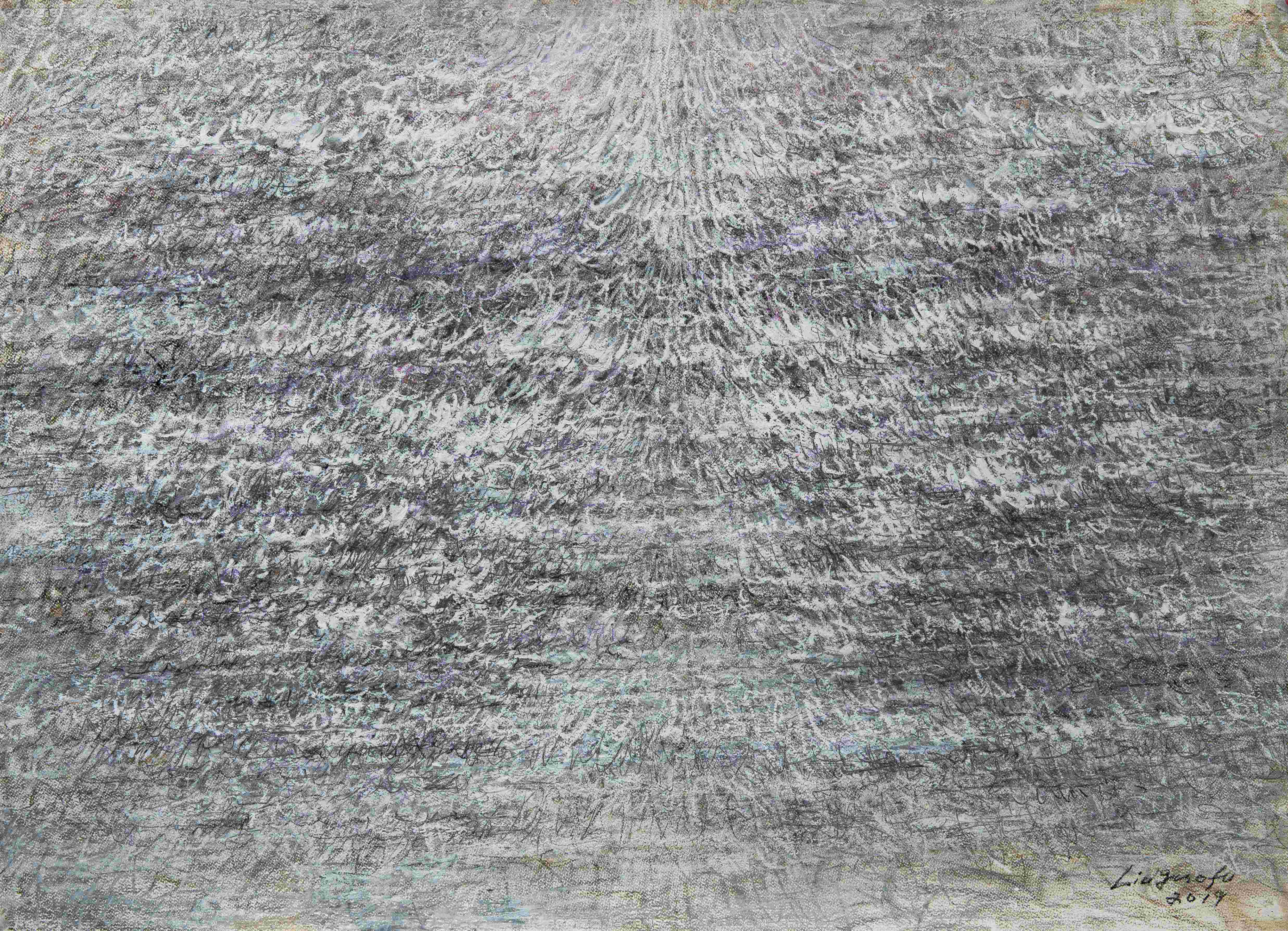
Liu Guofu, Pervasion No. P01, 2019, Oil pastel on paper, 79 x 108cm
Hui: Last year, in celebration of Sotheby’s Asia’s 50th anniversary, we held the “Liu Guofu: Requiem” exhibition at Sotheby’s Hong Kong Gallery. Felix, why did you choose Liu as the featured artist, and how did you feel when Liu’s works were finally presented at Sotheby’s?
Felix Kwok (hereafter referred to as Kwok): First and foremost, I’m a big fan of Mr. Liu. Although we hadn’t got a chance to host his first solo exhibition at Sotheby’s until last year, my appreciation to Mr. Liu and his creation sprouted around 2014 or 2015—nearly a decade ago. I first encountered his art in 2014 and was immediately struck by his extraordinary flair. Starting from around 2019, I got occasional opportunities to sell his works in auctions, and they were always well-received. After the pandemic, I finally managed to meet Mr. Liu in 2023 by courtesy of Mr. Hui’s introduction. We clicked right away on the first meet! Our intimate conversation in depth culminated into an agreement that a solo exhibition was the natural next step, leading to “Liu Guofu: Requiem” last year.
What resonates with me about Liu’s work is the profound sense of calm it evokes. Every time I stand at his paintings, gazing, a palpable feel of spiritual elevation uplifts me. The short video I made for Sotheby’s last time was just 3-minute long, but the interview I did with Mr. Liu was nearly 50 minutes (as there were too many things to delve into). I was deeply touched by his answer to “what is art” during our interview — ‘soothe the soul’. That sentiment informed our decision to name the exhibition “Requiem”, aiming to convey to viewers the essence of his work.

Installation view of "Liu Guofu: Requiem" at Sotheby's Hong Kong Gallery
Hui: Mr Liu, what core message or thoughts do you seek to evoke through your art?
Liu: Art, to me, is about evoking shared human emotions — the collective empathy that connects us all. I believe everyone experiences the ebb and flow of life, where frustration and helplessness alternate with joy and happiness. The true value of artistic creation lies in its ability to serve as a vehicle for emotional catharsis and expression. As part of society, I believe that if I channel my emotions candidly and sincerely into my art, it will inevitably resonate with viewers. This underscores why authenticity and honesty are essential in the creation of art.
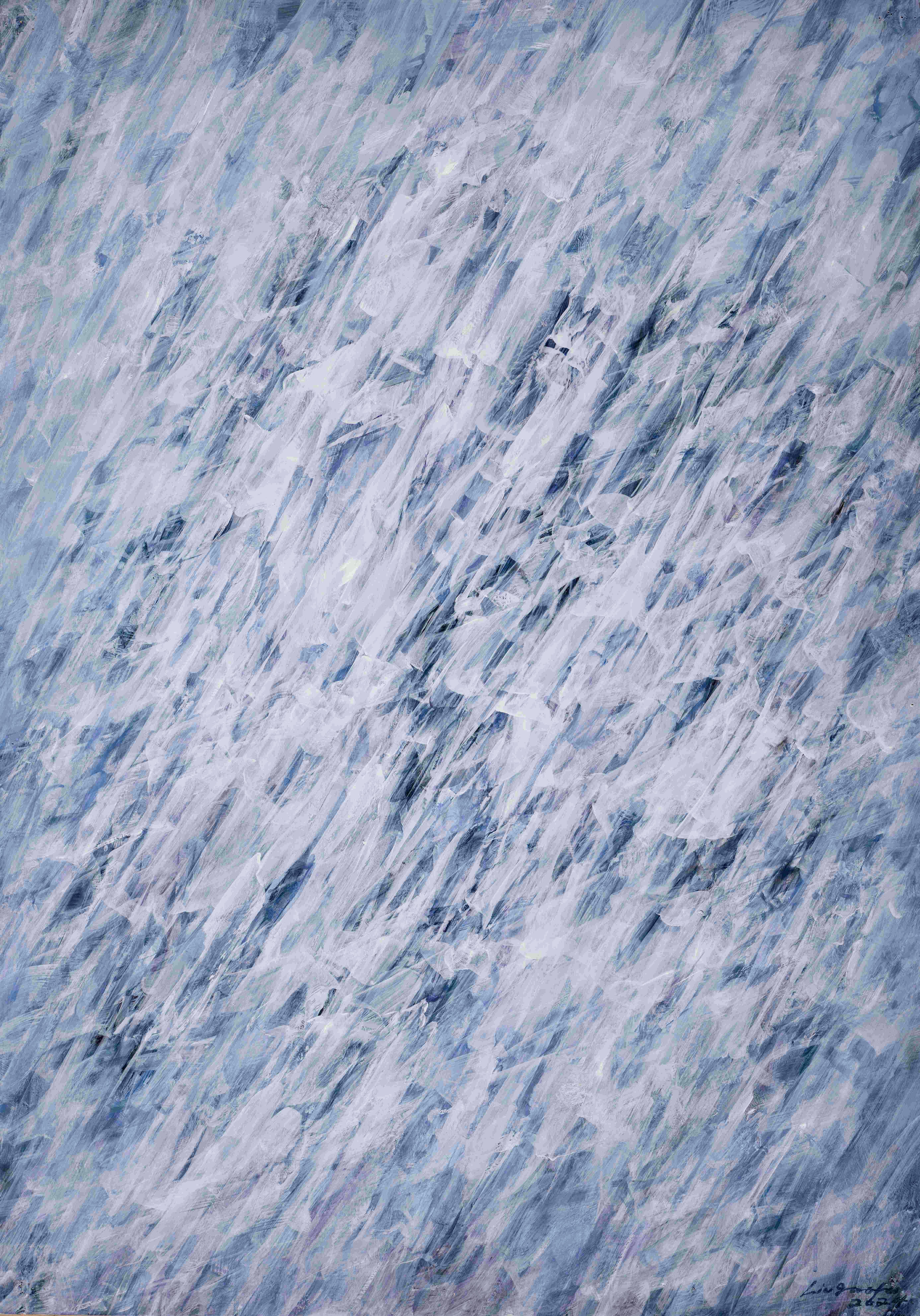
Liu Guofu, Cold Mountain Z-2, 2024, Oil on paper, 106 x 76cm
Most of my earlier works are characterised by imposing forms on an expansive scale. For instance, in pieces like Open Space, Cold Mountain, and Pervasion, the compositions give off a sense of abstraction and ambiguity, while the blurred and undefined edges that frame the subjects in the paintings enhance the visual impact of endless suffusion. However, two years ago, I shifted my focus back to flowers. It is a transition from a grandeur narrative to a more intimate and subtle one.
Dusk Upon the Hush, for example, is created on the premise that I perceive flowers as the symbol of life. In the work, you’ll see both blooming and withering flowers, which can be seen as a parallel to the alteration and coexistence of joy and sorrow in life.
Flowers are a staple in everyday life. When it comes to art creation, I am not inclined towards grandiose, or excessively potent and provocative themes. I maintain that the most important virtue in art — —perhaps even the artist's duty— is to offer a sensory revelation to things that have been taken for granted as a common sense in daily life. This concept of "strangeness" or presenting the ordinary in an unexpected way is something that I accentuate. I believe this visual discrepancy or contrast is central to the impact of art.
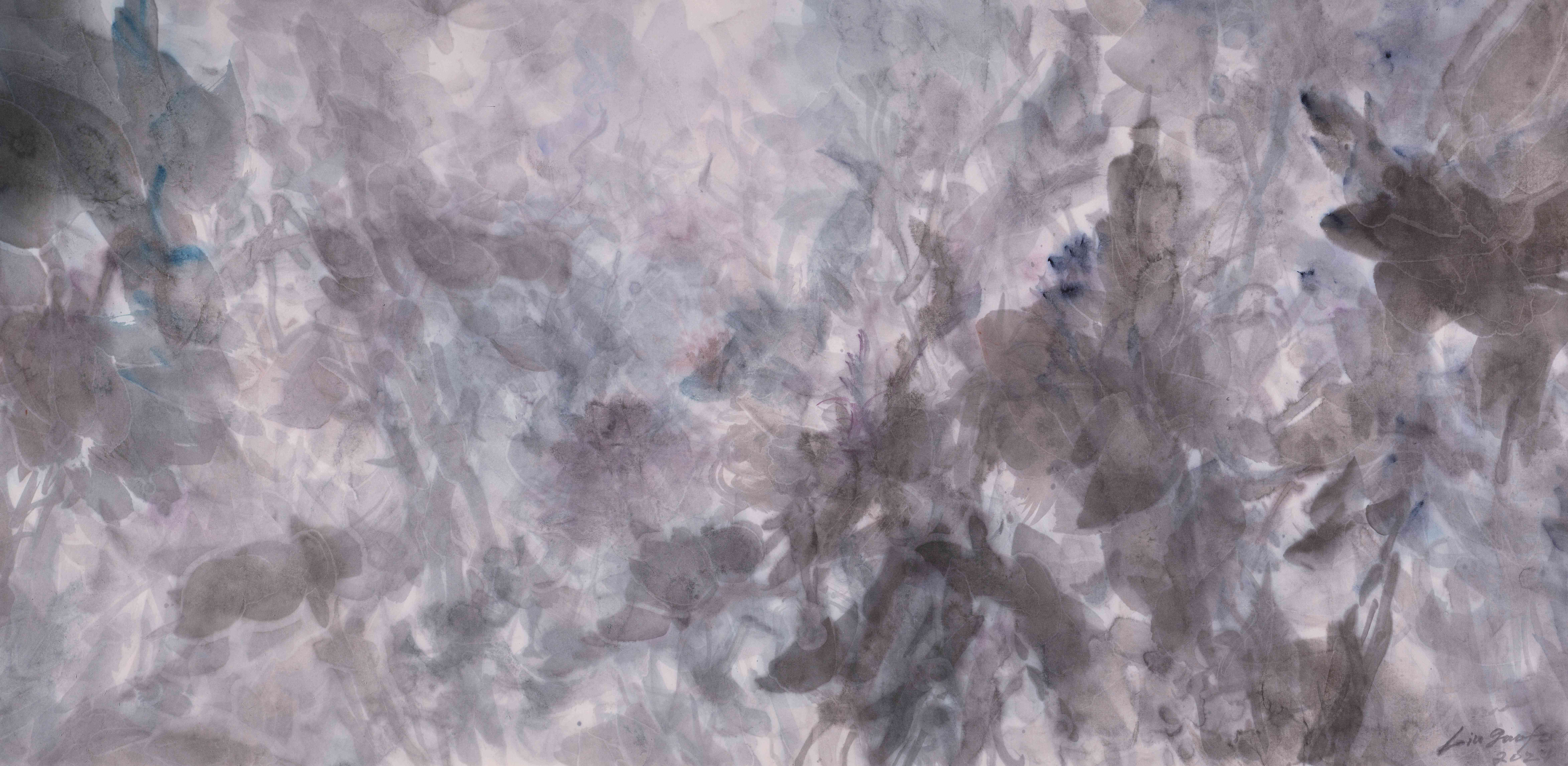
Liu Guofu, Dusk Upon the Hush - 3, 2024, Ink and colour on paper, 70 x 138cm
Hui: Felix, you reassure collectors and viewers that you have strong faith in Liu’s work. How would you perceive his art?
Kwok: First, I was deeply moved by Liu's work. As I mentioned earlier, I encountered his art long before meeting him in person—nearly eight years, to be exact. Fair to say, I was first captivated by the air of his well-executed works. Moreover, I found Liu's pieces to have a striking originality and uniqueness. Working in the auction business, we come across many different artists and their works. But Mr. Liu’s art still stands out. To quote Mr. Liu's words, it’s that sense of strangeness and contrast that left a lasting impression on me. I believe it’s a truly remarkable feeling.

Liu Guofu, Flower, Dusk Upon the Hush - 5, Flower, 2024 (from left), Ink on paper, 138 x 70cm
Hui: It is true that ink paintings are perceived to be very traditional, but, Mr. Liu, your work fuses Eastern beauty and Western contemporary aesthetics. How do you integrate this eclecticism into your creative practice?
Liu: There are two key aspects to reckon. First, in all my previous oil paintings on canvas, I have consistently emphasised the importance of "understanding." By "understanding," I mean identifying the core value of painting. This core essence lies in the artist's ability to present significant cultural influences they resonate with, using a uniquely distinctive artistic language or forms that stand in contrast to their own. The essence of art places great value on "difference" and “distinction."
In both art creation and daily life today, our experiences over the past hundred years have been largely taken references from the Western experiences and influences. This is quite palpable in our lives and artistic practices. As I mentioned earlier, art emphasises “differences” and “distinction”. So, no matter what we work on, we always need a frame of reference as a benchmark, which points to a proved and tested cultural phenomenon. For example, over the past century, starting from Paul Cézanne, through Western postmodernism and post-impressionism, up until today, these movements represent the cultural status at their respective certain era. Only when you get a hang of these established cultural forms and consciously emphasise "difference" in your work, can you create effectively. “Creating effectively” means always keeping in mind a core value during the creative process: "I must keep an arm’s length from the existing body of work, to create the ‘differences’.”

Liu Guofu, Flower Z-3, 2023, Oil on paper, 74 x 80cm
In my oil paintings on canvas, since I am very aware of the notion of "difference," I approach everything from the materials, to techniques, to artistic language in a way that is distinct from the Western counterparts which are marked by straightforward techniques and reliant on the understanding of materials. I aim for my work to embody a more fluid, translucent texture reminiscent of jade, which is characteristic of Chinese aesthetics. I strive to use thin, subtle, and distinctly Eastern techniques to achieve a resilience and stoicism characteristic of jade. As we discussed earlier, my art is rooted in a reverence for nature and life itself, so "nature" plays a key role in my work, representing both the unknown and change. "Water" fully embodies my understanding of the essence of art, which is why, when I describe my work, I often say I draw inspiration from the fluidity of Western watercolour and Chinese ink painting.
Regarding the starting point of my ink painting, I do not aim to use traditional Chinese ink or rice paper to achieve the conventional results that Chinese painters typically present in their work. As I mentioned earlier, my oil paintings on canvas draw inspiration from the fluidity or momentariness and texture of both Western watercolour and Chinese ink painting. Similarly, my approach to ink painting differs from that of traditional Chinese painters. By embracing a process of continuous negation, I evoke imagery or mirages that linger between "what is" and "what is not," a mindset deeply rooted in Chinese culture.
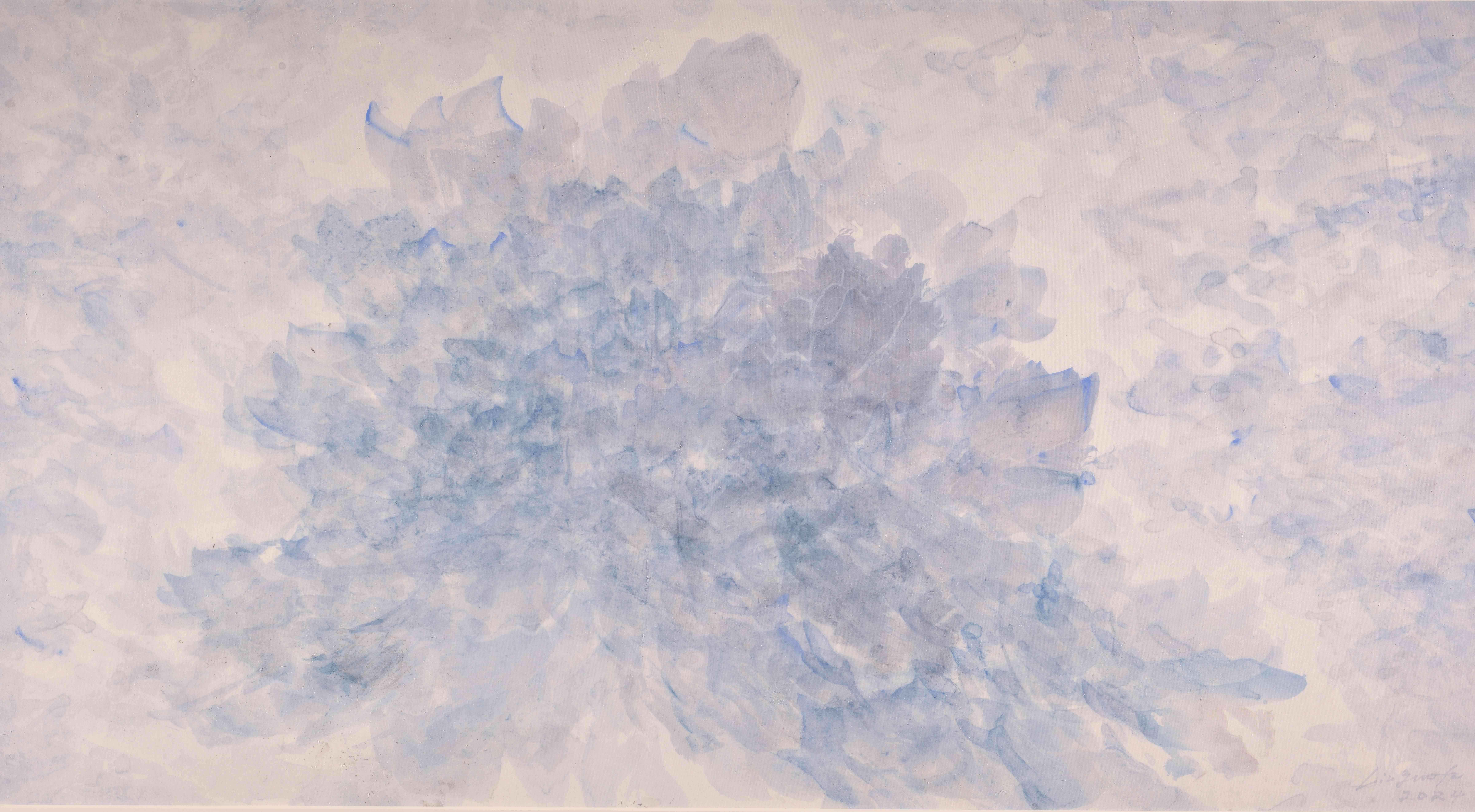
Liu Guofu, Dusk Upon the Hush - 2, 2024, Ink and colour on paper, 96 x 177cm
Kwok: Admiring Mr Liu’s works in Hong Kong allowed me to restore the memory of a lot of knowledge I had accumulated during my career. As an art practitioner with the expertise in Chinese modernism, I find myself a witness to Liu’s mature transformation and professional evolution by attending his solo oil painting exhibition “Requiem” and the brand-new exhibition “Dusk Upon the Hush” featuring works on paper. His attempt in circling back to the traditional Chinese mediums from the classic Western answers reminiscences me of the lessons that I’d absorbed from pioneering artists of Chinese modernism like Lin Fengmian, Wu Guanzhong, Guan Liang, and Ding Yanyong.
And it seems that Hong Kong has always had a particular fondness for ink painting. Think Lin Fengmian lived in Tai Koo Shing during his prime, Ding Yanyong resided on Cameron Road in Tsim Sha Tsui, and Guan Liang held a modern ink painting exhibition in Hong Kong in 1978. Now, at 3812 Gallery, we are witnessing Mr. Liu’s ink works debut for the first time. I am convinced that not only has Mr. Liu given a consummate full circle to his career, but also, he has represented the most devoted bastion continuing and perpetuating the historical movement of Chinese modernism. This movement illuminates Chinese artists’ conviction in ink and oil pastel on canvas, and the flexibility to dance between different mediums to craft distinctive artistic vernaculars.
Hui: Your oil paintings have a profound layers and depth, but it should be a challenge to achieve that in Chinese ink painting. How do you confront the challenge and how will continue your ink creation?
Liu: In my ink paintings, it involves at least five or six times of layering to achieve the intended effect, which is basally identical with the approach I employ in my oil paintings. But this approach is different from either the ‘cun’, or “wrinkling” technique prescribed in traditional ink art, or the upfront way of depiction of the seasons in a single stroke. Qi Baishi’s work, for instance, exhibits more realism in his depiction, yet with his own unique personal flair and playfulness.
However, I never try to imitate perceivable realities, because the depth of what can be conveyed through painting is infinite. I insist that an artist is expected to provide something that doesn’t exist, which decides that creation should not draw too much on every day, collective experience and common sense. Many people seem to explore specific narratives or characters through story plots, literature, philosophy, or sociology, as a clue to help them comprehend an art piece. This is important, but let’s not forget the visual experience itself. When you look at a painting, even if it’s just for 20 or 30 seconds, that initial sense of “alienness” is the most important vehicle to understand and appreciate art. In other words, we are discouraged to remember a painting by a narrative or yarn (that we establish in our mind), but rather through the visual takeaways at our first sight and impression, a unique visual experience.
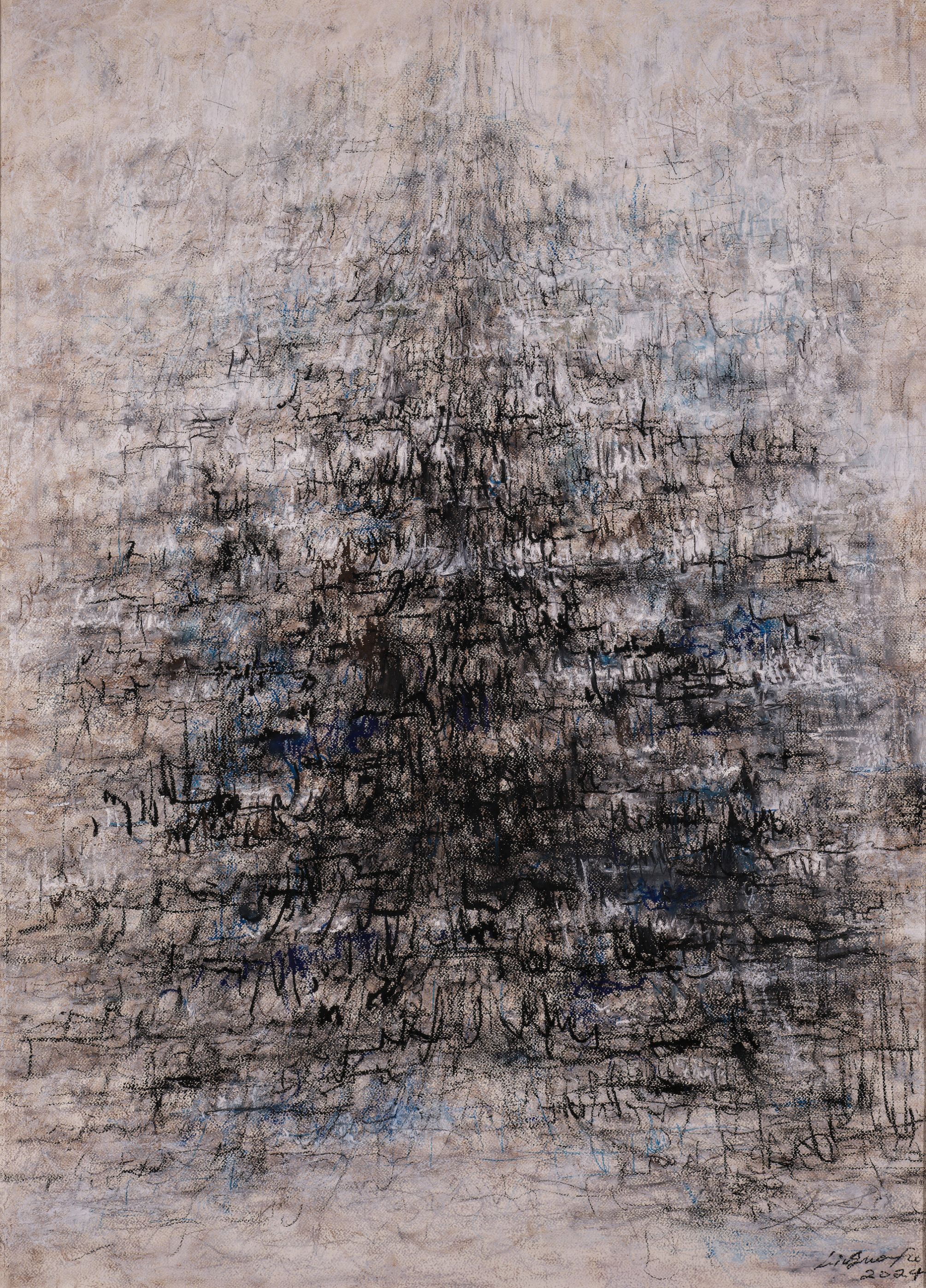
Liu Guofu, Untitled Z-2, 2024, Oil pastel on paper, 108 x 78cm

Artist talk at "Dusk upon the Hush: Liu Guofu Works on Paper Exhibition"

